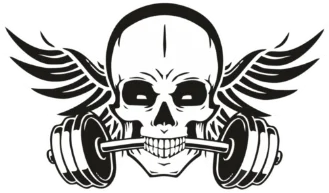Introduction:
When it comes to lifting heavier weights and enhancing your performance, weight lifting straps are one of the most valuable tools you can add to your workout routine.
For many lifters, grip strength is a major limiting factor. As you progress and lift heavier sets, grip fatigue can prevent you from pushing your limits, leading to a premature end to your workout. This is where weight lifting straps shine. These simple yet effective accessories help secure your grip, allowing you to lift more, increase your reps, and effectively target the muscles you're working to build.
In this guide, we'll dive into the benefits of weight-lifting straps, explore the available types, and explain how to use them correctly. Plus, we'll share top product recommendations from Body Reapers to help you choose the best lifting straps for your needs. Whether you're just starting or are an experienced lifter, mastering the proper use of lifting straps can take your training to new heights.
5 Key Benefits of Weight Lifting Straps
Grip strength can be a limiting factor in weightlifting, especially for exercises like deadlifts, rows, or pull-ups. Weight lifting straps provide a solution by offering several benefits that enhance your lifting routine.
Improved Grip Strength and Endurance
One of the most significant advantages of weight lifting straps is their ability to improve grip strength. Many lifters struggle to hold onto the bar as they increase the weight, causing premature fatigue in the forearms and hands. Straps alleviate this issue by securing the bar for you, allowing you to focus on engaging your muscles rather than worrying about your grip. This means lifting heavier weights for more reps improves muscle endurance.
A 2023 study found lifters deadlifted 27% heavier with straps vs. barehanded
Prevention of Grip Fatigue
Grip fatigue can quickly halt progress during lifts like deadlifts, rows, or pull-ups. When your grip weakens before your muscles do, your workout ends prematurely. Lifting straps support your grip, extending your training time. This added endurance helps you push through more sets, enhancing overall strength and muscle development.
Increased Lifting Capacity
Straps allow you to lift more weight by taking the pressure off your hands and wrists. With the added support, you can attempt heavier sets, which promotes muscle growth and strength. For example, a lifter may be limited to a certain weight because their grip fails first, but with lifting straps, they can handle more weight without worrying about their grip.
Reduced Risk of Injury
Poor wrist positioning can lead to injury when lifting heavy weights. Wrist straps, a type of lifting strap, stabilize the wrist, preventing strain and reducing the risk of injury, especially during demanding exercises like deadlifts or overhead presses. Straps ensure that your wrists are properly aligned, and the extra support can help prevent hyperextension and strain.
Focus on Target Muscles
Weightlifting straps allow you to direct all your energy into lifting the weight rather than worrying about maintaining a grip. This is particularly useful during compound lifts like deadlifts and rows, when you can focus on your back, legs, and shoulders, knowing that your hands and wrists are secure. This leads to more effective muscle engagement and better overall performance.
Bodybuilders using straps gained 5-8% more back mass in 12 weeks
Types of Lifting Straps Compared
Several lifting straps are available, each designed to meet specific needs. Let's examine the different options available and how they compare.
1. Easy Grip Weight Lifting Straps
Body Reapers Easy Grip Weight Lifting Straps are designed for comfort and support. Made from durable cotton with extra padding, these straps offer enhanced grip without compromising comfort. They're perfect for beginners learning to use lifting straps and lifters looking for a reliable, everyday option. The easy-to-use design allows for quick setup and practical support during workouts.
2. Weight Lifting Straps 24

These straps are ideal for more advanced lifters who need a more robust option. The Weight Lifting Straps 24 are made from reinforced materials that can handle heavy-duty lifts. They provide a secure fit and additional grip, which helps improve your lifting capacity on more challenging exercises like heavy deadlifts or shrugs. They're designed to give maximum support for your wrists while highly durable.
3. Wrist Wraps
Wrist wraps are a specific lifting strap that stabilizes the wrist joint. If you're performing overhead lifts like presses or snatches, wrist wraps can prevent wrist strain by securing your wrist in a neutral position. Body Reapers' Wrist Wraps offer an adjustable, tight fit to avoid unnecessary movement during heavy lifts, promoting proper form and reducing injury risk.
4. Weight Lifting Hooks

Weight Lifting Hooks are a more advanced type of lifting strap that utilizes a hook to latch onto the barbell. This design alleviates even more strain on the forearms by providing extra support, especially during heavy deadlifts or pull-ups. These hooks can be handy for athletes lifting at high intensities, but they require a bit of practice to get used to.
5. Figure 8 Lifting Straps

Figure 8 lifting straps are unique in their design, creating a double loop around the wrist and barbell. They provide the ultimate grip support, especially during heavy lifts like deadlifts. While these straps are effective, they take longer to set up and may not be ideal for beginners.
How to Use Weight Lifting Straps Properly
Step 1: Position the Strap Around Your Wrist
Thread the strap through the loop and secure it around your wrist. It should be snug but not tight enough to cause discomfort. A proper fit ensures the strap stays in place during heavy lifts.
Step 2: Wrap the Strap Around the Bar
Loop the strap under the barbell and around it, securing it tightly. The strap should assist your grip, relieving your fingers from bearing the full weight.
Step 3: Tighten the Strap
Pull the free end of the strap through the loop to tighten it. The strap should be firm, supporting the bar but not uncomfortable.
Lifting Straps Benefits: A tightly secured strap enhances grip strength, allowing you to lift more weight
Step 4: Perform Your Lift
With the strap securely fastened, perform your lift, focusing on form and muscle engagement without worrying about your grip.
Step 5: Release the Strap Safely
After you set it, carefully loosen and remove the straps. Take your time to avoid injury and preserve the straps' integrity.
Common Mistakes to Avoid
Misusing wrist straps can reduce their effectiveness and potentially cause injury. Here are some common mistakes to avoid:
- Over-Reliance: While straps help with grip strength, they should not replace grip training. Use them when necessary, but also work on building grip strength over time.
- Incorrect Fit: Too tight or loose Straps can cause discomfort and reduce their ability to support your grip effectively. Ensure that the straps are snug but not constrictive.
- Not Using Proper Form: Wrist straps should not be a crutch for poor form. Always prioritize good technique, especially when lifting heavy weights.
- Failure to Maintain Strap Condition: Lifting straps can wear out over time. Ensure they're in good condition to maintain their effectiveness.
When NOT to Use Lifting Straps
While lifting straps are incredibly useful, there are instances where you should avoid using them:
- When Training Grip Strength: If your goal is to improve grip strength, avoid using straps during training exercises specifically targeting your grip, such as farmer's walks or dead hangs.
- During Lighter Loads: For lighter-weight exercises, it's best to rely on your natural grip strength. Using straps during lighter sets can hinder the development of your grip and forearm muscles.
- For Every Single Lift: While straps are useful for heavy lifts, it's essential to learn to lift without them for exercises that don't require extra grip support. This will help prevent an over-reliance on straps and ensure overall muscular development.
Top Product Recommendations
At Body Reapers, we offer a variety of weight lifting straps to suit different training needs:
- Easy Grip Weight Lifting Straps – Perfect for beginners and everyday lifting, offering comfort and support.
- Weight Lifting Straps 24 – Heavy-duty straps designed for advanced lifters who need maximum support during intense lifts.
- Wrist Wraps – Ideal for stabilizing the wrists during overhead lifts or bench presses.
- Weight Lifting Hooks – Great for lifters who need extra support for high-intensity, heavy lifts.
- Figure 8 Lifting Straps – Best for experienced lifters who require the ultimate deadlift grip support.
Visit Body Reapers to explore our full range of lifting straps and accessories.
FAQs
Q: Are weight lifting straps necessary for all exercises?
A: No, lifting straps are most beneficial for heavy compound lifts where grip strength is a limiting factor, such as deadlifts and pull-ups.
Q: Can lifting straps prevent wrist injuries?
A: Yes, wrist straps support the wrist joint during heavy lifts, reducing the risk of strain or injury.
Q: How do I know when to use lifting straps?
A: Use straps when your grip fails during heavy sets or when performing high-volume exercises like deadlifts or rows.
Q: Can lifting straps help me lift heavier weights?
A: Lifting straps can allow you to lift heavier weights by providing better grip support, leading to increased muscle growth and strength.
In conclusion, weightlifting straps are essential for enhancing performance, reducing grip fatigue, and improving overall lifting capacity. Whether you're just starting out or you're a seasoned lifter, using straps correctly can help you achieve better results and prevent injuries. Be sure to choose the right straps for your training style and use them strategically for maximum benefit.






Leave a comment
This site is protected by hCaptcha and the hCaptcha Privacy Policy and Terms of Service apply.